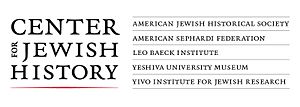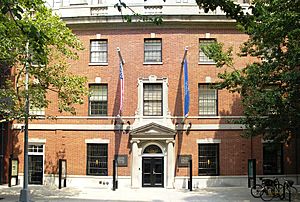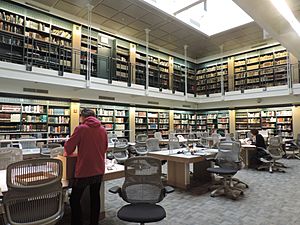Center for Jewish History facts for kids
|
||||||||||
The Center for Jewish History is a special place in New York City. It brings together five different groups that focus on Jewish history, learning, and art. These groups are the American Jewish Historical Society, American Sephardi Federation, Leo Baeck Institute New York, Yeshiva University Museum, and YIVO Institute for Jewish Research.
Even though they are separate, they all work together in one building. Their collections make up the largest collection of Jewish history in the United States. The Center is also a place for researchers, events, art shows, and performances. Inside, you'll find a reading room, a family history center, and a special area for taking care of old items. It is also connected to the famous Smithsonian Institution.
Contents
Discovering the Center's History
The Center for Jewish History first opened its doors in 2000. It took six years to plan and build this amazing place. The main goal was to help the five member organizations work together. Each group had a different way of looking at Jewish history and culture.
This big idea helped create the largest collection of Jewish experiences outside of Israel. Because of its large collection, some people even call it the "Jewish Library of Congress".
How the Idea Started
In the late 1980s, a man named Bruce Slovin had the idea for this united center. He was the chairman of YIVO at the time. He realized that YIVO's old building was not good enough. It couldn't meet the needs of visitors or properly store old documents. The old building didn't even have proper temperature control. This was bad for the collections and made it hard to study them.
The other groups were also in different places. The Leo Baeck Institute was on East 73rd Street. The American Jewish Historical Society was near Brandeis University in Waltham, Massachusetts. The Yeshiva University Museum was in the Washington Heights neighborhood. Bringing them all together made a lot of sense.
Overcoming Challenges
When the Center opened in October 2000, it faced some money problems. But in 2010, the Center for Jewish History was able to raise $30 million. This money helped them pay off the debt from building the Center. Many people and groups donated money to help.
In 2012, the Center received a top rating from Charity Navigator. This service checks how well non-profit groups are run. In 2013, the Center also received a large grant of $1.5 million. This money helped them create a new division for helping people find information.
Exploring the Facilities
The Center is located in the Chelsea neighborhood of Manhattan. It is a campus made up of four buildings that cover about 125,000 square feet. These buildings are built around a courtyard with a main entrance on 16th Street. Four of the buildings were once part of the American Foundation for the Blind. The Center added two new buildings in 2000.
Amazing Collections at the Center
The groups working at the Center have huge collections. They include more than 100 million documents and 500,000 books. There are also thousands of art objects, fabrics, special religious items, music, films, and photographs. Many of these items were at risk of being damaged before they came to the Center.
The Center works hard to protect these important records. Many of them show key moments in Jewish immigration to New York City. In 2007, a grant of $670,000 helped them create a central list of all the items. This makes it easier for people to find what they are looking for.
The collections cover a long period of history. They include items from early modern Europe and pre-colonial times in the Americas. They also have materials from all over the world up to today. You can find historical documents from famous people like Franz Kafka, Theodor Herzl, Moses Mendelssohn, Sigmund Freud, and Albert Einstein.
Besides old documents, the Center also has artwork by Max Lieberman. You can even see interesting everyday items, like philosopher Moses Mendelssohn's eyeglasses!
Special Items in the Collections
- The original handwritten copy of Emma Lazarus' 1883 poem, "The New Colossus". This poem was later put on the base of the Statue of Liberty.
- Sandy Koufax's Brooklyn Dodgers baseball jersey.
- A letter from Thomas Jefferson to New York's oldest Jewish community.
- The first Hebrew prayer books ever printed in America.
Digital Projects
The Center for Jewish History is also involved in digital projects. These projects help make their collections available online.
- In 2011, the Center started a two-year project. It was called "Illuminating Hidden Collections at the Center for Jewish History." They received a grant of $229,600 for this work.
- In 2013, the Center shared 600 images with the Google Art Project. This project is part of the Google Cultural Institute. It helps put cultural materials online for everyone to see. The Center was one of the first groups in New York City to join this project. The images are very clear and have lots of details.




